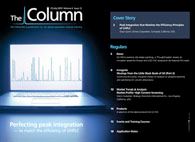GCxGC Symposium
The GC×GC-7 symposium ran concurrently with this year?s ISCC in Riva del Garda, Italy. Speaking with The Column, Philip Marriott of the Australian Centre for Research on Separation Science, RMIT, Melbourne, Australia, said it ?offered the most comprehensive and thorough GCxGC programme yet assembled.?

The GC×GC-7 symposium ran concurrently with this year’s ISCC in Riva del Garda, Italy. Speaking with The Column, Philip Marriott of the Australian Centre for Research on Separation Science, RMIT, Melbourne, Australia, said it “offered the most comprehensive and thorough GC×GC programme yet assembled.”
“The growth in interest in comprehensive two-dimensional gas chromatography is well characterized by the total registration for the GC×GC symposium” said Marriott. “There is a clear trend here, matched by the numbers of new groups who are entering the published literature of GC×GC and the perceived increased attention given to this subject.“
According to Marriott this year’s symposium included 30 lectures and 70 posters; these were in addition to the 10 lectures and 15 posters in the main ISCC programme. The papers and posters covered a range of areas where GC×GC is applied, and Marriott mentioned new detection possibilities; integration with odour studies; new implementation strategies; and interpretation of peak capacities and consideration of metrics for orthogonality.
The event also featured a People’s Choice award for the best articulation of the need for use of GC×GC technology. The award went to Chris Siegler, from the School of Chemistry, University of Washington, USA, for a poster on derivatized wild type yeast metabolite sample. This was an unusual poster because it was presented as a 3D image, revealed if you carefully study the poster whilst moving it away.
This story originally appeared in The Column. Click here to view that issue.
New Study Reviews Chromatography Methods for Flavonoid Analysis
April 21st 2025Flavonoids are widely used metabolites that carry out various functions in different industries, such as food and cosmetics. Detecting, separating, and quantifying them in fruit species can be a complicated process.
University of Rouen-Normandy Scientists Explore Eco-Friendly Sampling Approach for GC-HRMS
April 17th 2025Root exudates—substances secreted by living plant roots—are challenging to sample, as they are typically extracted using artificial devices and can vary widely in both quantity and composition across plant species.
Sorbonne Researchers Develop Miniaturized GC Detector for VOC Analysis
April 16th 2025A team of scientists from the Paris university developed and optimized MAVERIC, a miniaturized and autonomous gas chromatography (GC) system coupled to a nano-gravimetric detector (NGD) based on a NEMS (nano-electromechanical-system) resonator.
Miniaturized GC–MS Method for BVOC Analysis of Spanish Trees
April 16th 2025University of Valladolid scientists used a miniaturized method for analyzing biogenic volatile organic compounds (BVOCs) emitted by tree species, using headspace solid-phase microextraction coupled with gas chromatography and quadrupole time-of-flight mass spectrometry (HS-SPME-GC–QTOF-MS) has been developed.

.png&w=3840&q=75)

.png&w=3840&q=75)



.png&w=3840&q=75)



.png&w=3840&q=75)













